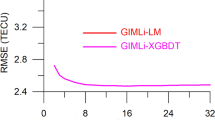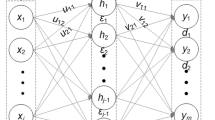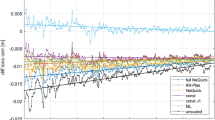Abstract
Machine learning approaches are introduced to model the three-dimensional topside total electron content (TEC) using multiple low Earth orbit (LEO) satellites. The three-dimensional topside TEC can be described by empirical models, such as the NeQuick-G or IRI-2016 model, which has limited accuracy. In this study, we proposed two models based on eXtreme Gradient Boosting (XGBoost) and neural network (NN) to estimate the three-dimensional topside TEC. The models were trained using onboard GNSS observations from 21 LEO satellites at different orbit altitudes, and a genetic algorithm (GA) was applied to optimize the hyperparameters of models. The differential slant total electron content (dSTEC) assessment shows that the XGBoost-GA model outperforms the IRI-2016 and NeQuick-G models, and an accuracy improvement of about 19.5% and 44.8% can be achieved, respectively. Compared to the empirical models, the XGBoost-GA model also achieves an accuracy improvement of about 40% in the LEO-based vertical TEC (VTEC) accuracy. XGBoost-GA and NN-GA also outperform the empirical models in terms of positioning accuracy. With more LEO satellites, ML techniques can be a key processing approach in modeling the topside ionosphere.







Similar content being viewed by others
Data availability
The DCB products can be obtained from ftp://ftp.gipp.org.cn/product/dcb. The IGS data used in this study is acquired from the CDDIS (https://cddis.nasa.gov) via registration. The solar activity and geomagnetic indices can be found in the OMNI website https://omniweb.gsfc.nasa.gov. Onboard GNSS observations of LEO satellites can be found in https://swarm-diss.eo.esa.int; https://scihub.copernicus.eu/gnss; https://data.cosmic.ucar.edu/gnss-ro; https://podaac.jpl.nasa.gov. The author thanks the IRI working group provides access to the IRI model (https://irimodel.org/IRI-2016/), and the NeQuick-G model can be obtained at https://www.gsc-europa.eu/support-to-developers/nequick-g-source-code. Trained ML-based models and the example data are available in https://www.zenodo.org/record/8052389.
References
Abuelezz OA, Mahrous AM, Cilliers PJ, Fleury R, Youssef M, Nedal M, Yassen AM (2021) Neural network prediction of the topside electron content over the Euro-African sector derived from Swarm–a measurements. Adv Space Res 67(4):1191–1209. https://doi.org/10.1016/j.asr.2020.11.009
Bilitza D, McKinnell LA, Reinisch B, Fuller-Rowell T (2011) The international reference ionosphere today and in the future. J Geod 85(12):909–920. https://doi.org/10.1007/s00190-010-0427-x
Breiman L (2001) Random forests. Mach Learn 45:5–32
Chen P, Yao Y, Li Q, Yao W (2017) Modeling the plasmasphere based on LEO satellites onboard GPS measurements. J Geophys Res Space Phys 122(1):1221–1233. https://doi.org/10.1002/2016JA023375
Chen J, Zhi N, Liao H, Lu M, Feng S (2022) Global forecasting of ionospheric vertical total electron contents via ConvLSTM with spectrum analysis. GPS Solut 26(3):1–10. https://doi.org/10.1007/s10291-022-01253-z
Chen T, Guestrin C (2016) XGBoost: a scalable tree boosting system. In: Proceedings of the 22nd ACM SIGKDD international conference on knowledge discovery and data mining. ACM, New York, NY, USA, pp 785–794
Ciraolo L, Azpilicueta F, Brunini C, Meza A, Radicella SM (2007) Calibration errors on experimental slant total electron content (TEC) determined with GPS. J Geod 81(2):111–120. https://doi.org/10.1007/s00190-006-0093-1
Dutta S, Cohen MB (2021) Modeling electron density in the topside of the ionosphere using machine learning. In: 2021 XXXIVth General assembly and scientific symposium of the international union of radio science (URSI GASS). IEEE, pp 1–4
Feltens J, Angling M, Jackson-Booth N, Jakowski N, Hoque M, Hernández-Pajares M, Aragón-Àngel A, Orús R, Zandbergen R (2011) Comparative testing of four ionospheric models driven with GPS measurements. Radio Sci 46(06):1–11. https://doi.org/10.1029/2010RS004584
Feurer M, Hutter F (2019) Hyperparameter optimization. Automated machine learning. Springer, Cham, pp 3–33
Foelsche U, Kirchengast G (2002) A simple “geometric” mapping function for the hydrostatic delay at radio frequencies and assessment of its performance. Geophys Res Lett 29(10):111-1-111–4. https://doi.org/10.1029/2001gl013744
Friedman JH (2001) Greedy function approximation: a gradient boosting machine. Ann Stat 29:1189–1232
Gowtam VS, Tulasi Ram S, Reinisch B, Prajapati A (2019) A new artificial neural network-based global three-dimensional ionospheric model (ANNIM-3D) using long-term ionospheric observations: preliminary results. J Geophys Res Space Phys 124(6):4639–4657. https://doi.org/10.1029/2019JA026540
Han Y, Wang L, Chen R, Fu W, Li T, Zhou H (2022a) Toward real-time construction of global ionosphere map from ground and spaceborne observations. GPS Solut 26(4):147. https://doi.org/10.1007/s10291-022-01337-w
Han Y, Wang L, Fu W, Zhou H, Li T, Chen R (2022b) Machine learning-based short-term GPS TEC forecasting during high solar activity and magnetic storm periods. IEEE J Sel Top Appl Earth Obs Remote Sens 15:115–126. https://doi.org/10.1109/JSTARS.2021.3132049
Hearst MA, Dumais ST, Osuna E, Platt J, Scholkopf B (1998) Support vector machines. IEEE Intell Syst Appl 13(4):18–28
Heise S, Jakowski N, Wehrenpfennig A, Reigber C, Lühr H (2002) Sounding of the topside ionosphere/plasmasphere based on GPS measurements from CHAMP: initial results. Geophys Res Lett 29(14):2–5. https://doi.org/10.1029/2002GL014738
Hernández-Pajares M, Roma-Dollase D, Krankowski A, García-Rigo A, Orús-Pérez R (2017) Methodology and consistency of slant and vertical assessments for ionospheric electron content models. J Geod 91(12):1405–1414. https://doi.org/10.1007/s00190-017-1032-z
Hofmann-Wellenhof B, Lichtenegger H, Wasle E (2007) GNSS–global navigation satellite systems: GPS, GLONASS, Galileo, and more. Springer, Cham
Liu A, Wang N, Li Z, Wang Z, Yuan H (2019) Assessment of NeQuick and IRI-2016 models during different geomagnetic activities in global scale: comparison with GPS-TEC, dSTEC Jason-TEC and GIM. Adv Space Res 63(12):3978–3992. https://doi.org/10.1016/j.asr.2019.02.032
Montenbruck O, González Rodríguez B (2020) NeQuick-G performance assessment for space applications. GPS Solut 24(1):1–12. https://doi.org/10.1007/s10291-019-0931-2
Nava B, Coïsson P, Radicella SM (2008) A new version of the NeQuick ionosphere electron density model. J Atmos Solar Terr Phys 70(15):1856–1862. https://doi.org/10.1016/j.jastp.2008.01.015
Prol FS, Hernández-Pajares M, Camargo PO, Muella MTAH (2018) Spatial and temporal features of the topside ionospheric electron density by a new model based on GPS radio occultation data. J Geophys Res Space Phys 123(3):2104–2115. https://doi.org/10.1002/2017JA024936
Ren X, Chen J, Zhang X, Schmidt M, Li X, Zhang J (2020a) Mapping topside ionospheric vertical electron content from multiple LEO satellites at different orbital altitudes. J Geod 94(9):1–17. https://doi.org/10.1007/s00190-020-01415-2
Ren X, Chen J, Zhang X, Yang P (2020b) Topside ionosphere of NeQuick2 and IRI-2016 Validated by using onboard gps observations from multiple LEO satellites. J Geophys Res Space Phys. https://doi.org/10.1029/2020JA027999
Smirnov A, Shprits Y, Prol F, Lühr H, Berrendorf M, Zhelavskaya I, Xiong C (2023) A novel neural network model of Earth’s topside ionosphere. Sci Rep 13(1):1–14. https://doi.org/10.1038/s41598-023-28034-z
Srivani I, Siva Vara Prasad G, Venkata Ratnam D (2019) A deep learning-based approach to forecast ionospheric delays for GPS signals. IEEE Geosci Remote Sens Lett 16(8):1180–1184. https://doi.org/10.1109/LGRS.2019.2895112
Tao H, Habib M, Aljarah I, Faris H, Afan HA, Yaseen ZM (2021) An intelligent evolutionary extreme gradient boosting algorithm development for modeling scour depths under submerged weir. Inf Sci 570:172–184. https://doi.org/10.1016/j.ins.2021.04.063
Vasiliev A, Yasyukevich Y, Garashchenko A, Edemskiy I, Vesnin A, Sidorov D (2021) Computer vision for GNSS-based detection of the auroral oval boundary. Int J Artif Intell 19(2):132–151
Wang N, Yuan Y, Li Z, Montenbruck O, Tan B (2016) Determination of differential code biases with multi-GNSS observations. J Geod 90(3):209–228. https://doi.org/10.1007/s00190-015-0867-4
Whitley D (1994) A genetic algorithm tutorial. Stat Comput 4(2):65–85. https://doi.org/10.1007/BF00175354
Yue X, Schreiner WS, Hunt DC, Rocken C, Kuo YH (2011) Quantitative evaluation of the low Earth orbit satellite based slant total electron content determination. Space Weather 9(9):1–14. https://doi.org/10.1029/2011SW000687
Zakharenkova I, Cherniak I (2015) How can GOCE and TerraSAR-X contribute to the topside ionosphere and plasmasphere research? Space Weather 13(5):271–285. https://doi.org/10.1002/2015SW001162
Zhang X, Tang L (2014) Daily global plasmaspheric maps derived from COSMIC GPS observations. IEEE Trans Geosci Remote Sens 52(10):6040–6046. https://doi.org/10.1109/TGRS.2013.2294641
Zhang G, Patuwo BE, Hu MY (1998) Forecasting with artificial neural networks: the state of the art. Int J Forecast 14(1):35–62. https://doi.org/10.1016/S0169-2070(97)00044-7
Zhong J, Lei J, Dou X, Yue X (2016) Assessment of vertical TEC mapping functions for space-based GNSS observations. GPS Solut 20(3):353–362. https://doi.org/10.1007/s10291-015-0444-6
Zhukov AV, Yasyukevich YV, Bykov AE (2021) GIMLi: global Ionospheric total electron content model based on machine learning. GPS Solut 25(1):1–9. https://doi.org/10.1007/s10291-020-01055-1
Acknowledgements
This research is financially supported by the National Natural Science Foundation of China (NSFC 42074036) and the Fundamental Research Funds for the Central Universities (2042022dx0001, 2042023kf0003). The numerical calculations in this study are performed on the supercomputing system of the Supercomputing Center of Wuhan University.
Funding
National Natural Science Foundation of China (42,074,036), Fundamental Research Funds for the Central Universities (2042022dx0001, 2042023kf0003).
Author information
Authors and Affiliations
Corresponding author
Additional information
Publisher's Note
Springer Nature remains neutral with regard to jurisdictional claims in published maps and institutional affiliations.
Rights and permissions
Springer Nature or its licensor (e.g. a society or other partner) holds exclusive rights to this article under a publishing agreement with the author(s) or other rightsholder(s); author self-archiving of the accepted manuscript version of this article is solely governed by the terms of such publishing agreement and applicable law.
About this article
Cite this article
Han, Y., Wang, L., Chen, R. et al. Topside ionospheric TEC modeling using multiple LEO satellites based on genetic algorithm-optimized machine learning models. GPS Solut 28, 19 (2024). https://doi.org/10.1007/s10291-023-01565-8
Received:
Accepted:
Published:
DOI: https://doi.org/10.1007/s10291-023-01565-8




